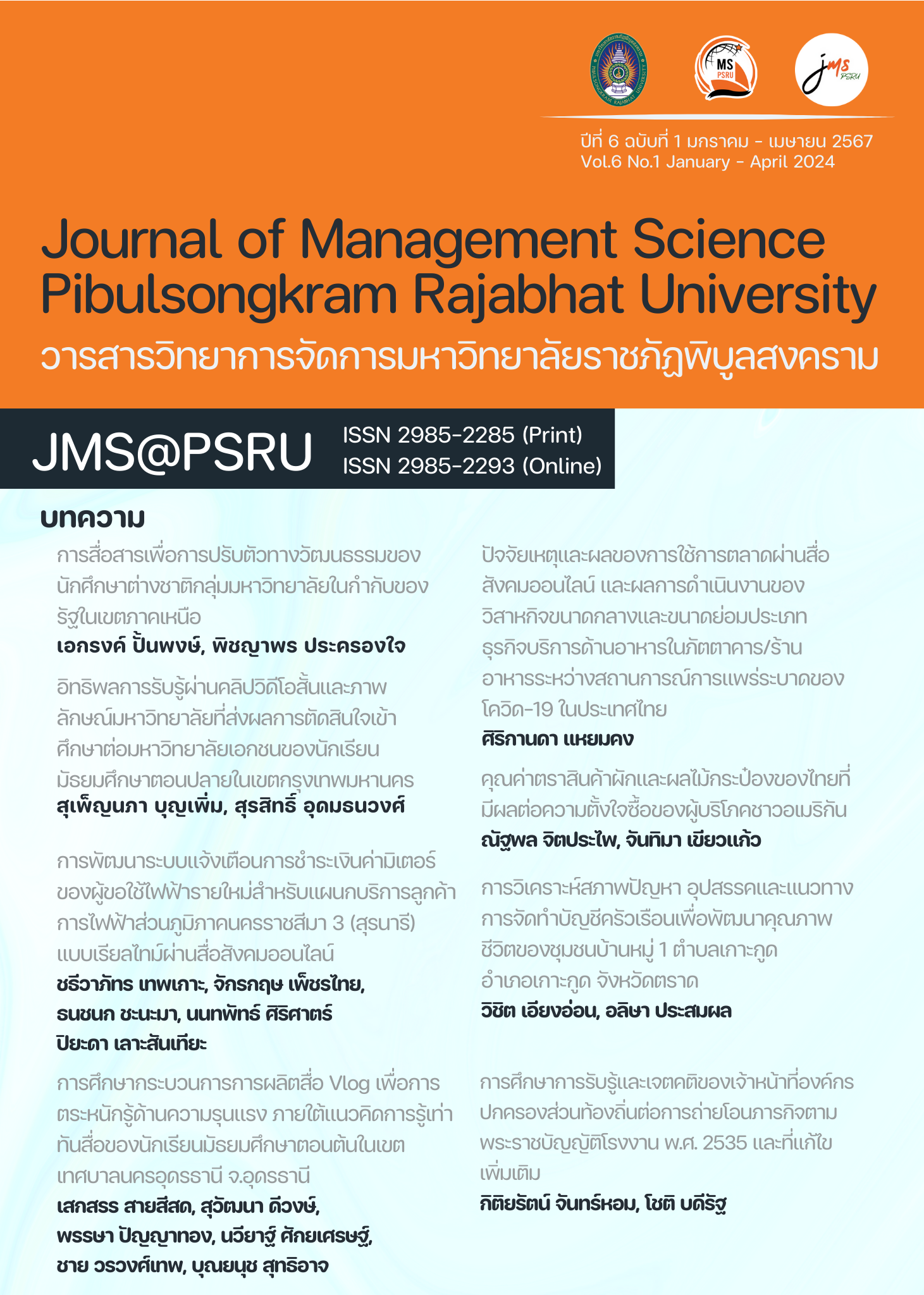คุณค่าตราสินค้าผักและผลไม้กระป๋องของไทยที่มีผลต่อความตั้งใจซื้อ ของผู้บริโภคชาวอเมริกัน
คำสำคัญ:
คุณค่าตราสินค้า , ความตั้งใจซื้อ , ผักและผลไม้กระป๋อง , ตราสินค้าไทยบทคัดย่อ
การวิจัยครั้งนี้เป็นการวิจัยเชิงปริมาณมีวัตถุประสงค์เพื่อศึกษาคุณค่าตราสินค้าผักและผลไม้กระป๋องของไทยที่ส่งผลต่อความตั้งใจซื้อของผู้บริโภคชาวอเมริกัน เก็บข้อมูลโดยใช้แบบสอบถามจากกลุ่มตัวอย่าง คือ ผู้บริโภคที่เป็นพลเมืองอเมริกันที่อยู่ในประเทศสหรัฐอเมริกา จำนวน 400 คน สถิติที่ใช้ในการวิเคราะห์
คือ สถิติเชิงพรรณนา ได้แก่ ความถี่ ร้อยละ ค่าเฉลี่ย และส่วนเบี่ยงเบนมาตรฐาน และสถิติเชิงอนุมานเพื่อทดสอบสมมติฐาน ได้แก่ สถิติวิเคราะห์การถดถอยพหุคุณ ผลการวิจัยพบว่า ปัจจัยด้านการตระหนักรู้ต่อตราสินค้าและปัจจัยด้านความภักดีต่อตราสินค้าส่งผลต่อความตั้งใจซื้อตราสินค้าผักและผลไม้กระป๋องของไทยในทิศทางบวกอย่างมีนัยสำคัญทางสถิตที่ระดับนัยสำคัญ .05 มีค่าสัมประสิทธิ์สหสัมพันธ์ถดถอยปรับมาตรฐาน เท่ากับ 0.50 และ 0.21ตามลำดับ ดังนั้น นักสื่อสารการตลาดควรสื่อตราสินค้าเพื่อสร้างการจดจำได้ง่าย รวมถึงการสร้างโปรแกรมความภักดีต่อตราสินค้ากับผู้บริโภคคนสุดท้ายและคนกลางทางการตลาดเพื่อทำให้ตราสินค้ามีคุณค่าสูงมากขึ้น
เอกสารอ้างอิง
กรมส่งเสริมการค้าระหว่างประเทศ. (2565). การส่งออกผัก ผลไม้กระป๋องและแปรรูป. สืบค้น 27 ธันวาคม2565, จาก https://www.ditp.go.th/contents_attach/774674/774674.pdf
ธานินทร์ ศิลป์จารุ. (2563). การวิจัยและวิเคราะห์ข้อมูลทางสถิติด้วย SPSS และ AMOS (พิมพ์ครั้งที่ 18). กรุงเทพมหานคร: ห้างหุ้นส่วนสามัญบิสซิเนสอาร์แอนด์ดี.
ธนาคารแห่งประเทศไทย. (2566). มูลค่าและปริมาณสินค้าออกจำแนกตามกิจกรรมการผลิต. สืบค้น 5 มกราคม 2566, จาก https://www.boi.go.th/index.php?page=exports_by_product_classification
Aaker. D. A. (1991). Managing Brand Equity. New Year: Free Press.
Aaker. D. A. (2009). Managing brand equity. Simon and Schuster.
Aaker. D. A. (2010). Building strong brands. Simon & Schuster.
Abraham, V., & Poria, Y. (2020). Political identification, animosity, and consequences on tourist attitudes and behaviours. Current Issues in Tourism, 23(24), 3093-3110.
Ahmed, S. (2020). Effect of Brand Equity on Consumer Buying Behavior. Journal of Marketing Strategies, 2(2), 101-116.
Ajzen, I., & Fishbein, M. (2004). Questions Raised by a Reasoned Action Approach: Comment on Ogden (2003). Health Psychology, 23(4), 431–434.
Cochran, W.G. (1953). Sampling Techniques. New York: John Wiley & Sons. Inc.
Cronbach, L. J. (1990). Essentials of Psychological Testing. HarperCollins Publishers.
Danilwan, Y., Dirhamsyah, D., & Pratama, I. (2020). The impact of consumer ethnocentrism, animosity and product judgment on the willingness to buy. Polish Journal of Management Studies, 22(2), 65–81.
Hakala, U., Svensson, J., & Vincze, Z. (2012). Consumer‐based brand equity and top‐of‐mind awareness: a cross‐country analysis. Journal of Product & Brand Management, 21(6), 439–451.
Hoeffler, S., & Keller, K. L. (2003). The marketing advantages of strong brands. Journal of Brand Management, 10(6), 421–445.
Keller, K. L. (1998). Branding perspectives on social marketing. ACR North American Advances.
Keller, K. L., Parameswaran, M. G., & Jacob, I. (2011). Strategic brand management: Building, measuring, and managing brand equity. India: Pearson Education India.
Kotler, P., Keller, K. L., and Chernev, A. (2022). Marketing management. Pearson Education.
Jalilvand, M. R., Samiei, N., & Mahdavinia, S. H. (2011). The effect of brand equity components on purchase intention: An application of Aaker’s model in the automobile industry. International business and management, 2(2), 149-158.
Lakshmi, S., & Kavida, V. (2016). Impact of Brand Equity on Purchase Intention of Home Appliances. IUP Journal of Brand Management, 13(4). 54-67.
Lin, Y. (2016). An examination of determinants of trade show exhibitors’ behavioral intention. International Journal of Contemporary Hospitality Management, 28(12), 2630–2653.
Oyedele, A., Saldivar, R., Hernandez, M. D., & Goenner, E. (2018). Modeling satisfaction and repurchase intentions of mobile smart wristbands: the role of social mindfulness and perceived value. Young Consumers, 19(3), 237–250.
Rizwan, S., Al-Malkawi, H. A., Gadar, K., Sentosa, I., & Abdullah, N. (2021). Impact of brand equity on purchase intentions: empirical evidence from the healthtakāfulindustry of the United Arab Emirates. ISRA International Journal of Islamic Finance, 13(3), 349–365.
Rungsrisawat, S., & Sirinapatpokin, S. (2019). Impact of brand equity on consumer purchase intent. Utopía y praxis latinoamericana: revista internacional de filosofía iberoamericana y teoría social, 24(1), 360-369.
Shah, S. M., Adeel, M., Hanif, F., & Khan, M. (2016). The Impact of Brand Equity on Purchase Intensions with Modertaing Role of Subjective Norms. Universal Journal of Industrial and Business Management, 4(1), 18–24.
Wang, Y., Kim, J., & Kim, J. (2021). The financial impact of online customer reviews in the restaurant industry: A moderating effect of brand equity. International Journal of Hospitality Management, 95, 102895.
ดาวน์โหลด
เผยแพร่แล้ว
รูปแบบการอ้างอิง
ฉบับ
ประเภทบทความ
สัญญาอนุญาต
ลิขสิทธิ์ (c) 2024 คณะวิทยาการจัดการ มหาวิทยาลัยราชภัฎพิบูลสงคราม

อนุญาตภายใต้เงื่อนไข Creative Commons Attribution-NonCommercial-NoDerivatives 4.0 International License.
บทความที่ได้รับการตีพิมพ์ในวารสารวิทยาการจัดการมหาวิทยาลัยราชภัฏพิบูลสงคราม เป็นลิขสิทธิ์ของ คณะวิทยาการจัดการ มหาวิทยาลัยราชภัฎพิบูลสงคราม บทความที่ลงพิมพ์ใน วารสารวิทยาการจัดการมหาวิทยาลัยราชภัฎพิบูลสงคราม ถือว่าเป็นความเห็นส่วนตัวของผู้เขียน คณะบรรณาธิการไม่จำเป็นต้องเห็นด้วย ผู้เขียนต้องรับผิดชอบต่อบทความของตนเอง



